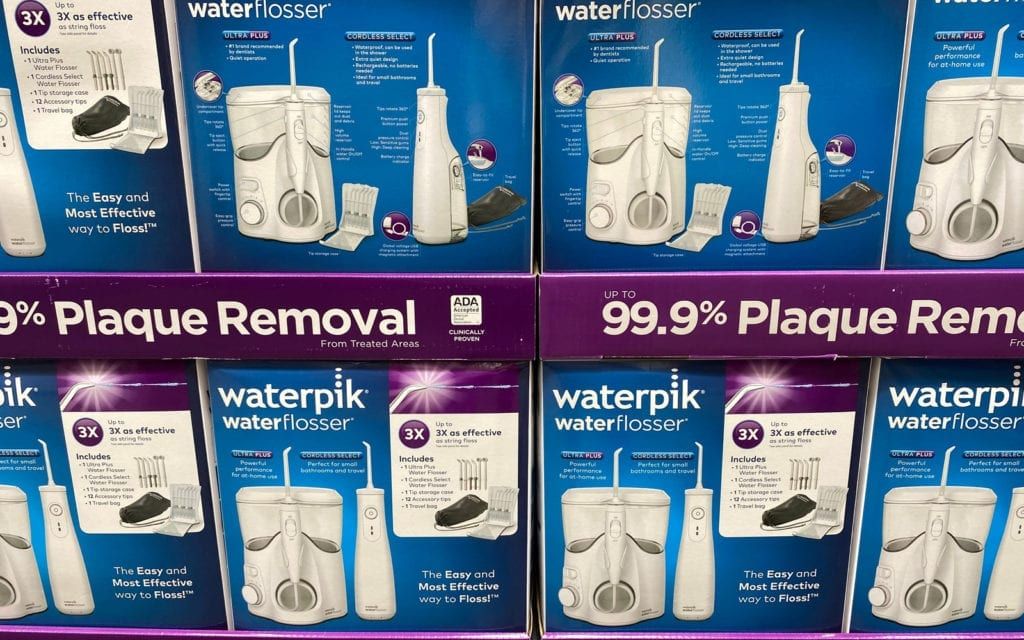Any dentist will tell you that to best keep your teeth healthy, brushing and flossing are essential. Dentists can be enthused about new dental products and medical-grade dental tools that can benefit patients both in the office and outside the office. We love learning about the innovations that our dental suppliers provide for us to help our patients gain better oral health and have a beautiful smile at the end of it all. However, when new products enter the market, we as dentists have to research and evidence behind those products to assure our patients that they work and are safe to use.
Water flossers are just one of the many products that have come out in recent years, presenting people with another option for flossing their teeth. Also called an oral irrigator, the device has occurred within the last few decades as a revolutionary device that allows those unable to use floss to clean in between their teeth. But how exactly do these devices work? Are they clinically approved? Do they offer the same benefits as regular flossing? Many of these questions have surfaced over time, and where we’re going to discuss everything related to water flossers and how they may help you clean your teeth.
What is Waterflosser?
Water flossers are devices that use high-pressure, pulsating water to remove plaque and food debris in between teeth. The first water flosser was designed in 1962, and since then, these irrigators have been evaluated for their ability to maintain not just oral health but also maintain periodontal maintenance. This device works by filling the tank with water, and then when turned on, pulses and streams of water emit out of the nozzle. With this, people can aim the water at their teeth and clean the teeth and gum line.
Are Waterflossers Clinically Approved?
The ADA approved the use of water flossers, specifically the Waterpik water flosser product line. Waterpik, the first company to invent the water flossers in the 1960s, has since expanded across the United States to produce a variety of product lines to meet consumers’ needs. According to the ADA, the Waterpik has been shown to reduce plaque and gingivitis in areas between the teeth, and thus they granted the ADA Seal of Acceptance. The ADA marked the water flosser as a product that can be an effective alternative to string floss.
The Benefits of The Water Flosser
For those who don’t like regular floss, the water flosser can prove many benefits and create a seamless, even calming experience for those wishing to clean in between their teeth. Those benefits include:
- Adjustable Pressure: Many Waterpik water flossers have the option of water pressure adjustment, making it easier to clean sensitive teeth.
- Pulsating Water: The pulsating water produces gentle streams between the teeth and removes the uncomfortable sensation often experienced with string floss.
- Braces Safe: For those who wear braces regularly, the Waterpik makes it easier for those with braces to clean in between their teeth without removing rubber bands and pins.
- Great for Restorations: People who have had restorative work done, including implants, crowns, and bridgework, will experience an easier time with the water flosser, as it doesn’t create friction between the natural teeth and restorations, which can overtime cause long-term damage when using string floss.
- Arthritis-Friendly: Those with arthritis will also have a better time using the Waterpik than with string floss due to the lack of pressure the water flosser produces and the easy-hold nozzle for cleaning.
The Disadvantages of the Water Flosser
Out of all the advantages of a water flosser, one of the main disadvantages of these devices is their costs. Depending on the company chose, both Waterpik and Phillips have water flossers that can cost between $40 and over $100. Even if you consider the costs of string floss and average out the yearly cost for spending, string floss costs significantly less than water flossers. Those who purchase string floss save between $16 and $75 compared to the price of water flossers, as the average costs annually people spend on string floss amounts to $24.
Another important aspect to consider when choosing water flossers is their warranty and its costs to repair or replace the machine. Most water flossers offer a three-year warranty when purchased—depending on the voltage, reservoir tank, and other features present, getting the most out of your money if the machine breaks due to constant use and can make purchasing a water flosser quite risky.
One more aspect to consider is the reputation of the products and the potential downfalls that have previously occurred. The FDA previously reported a class 2 recall of the Waterpik SonicFusion professional back in 2018 due to how the charging base would overheat, causing melting, sparking, fires, and burns. All customers who reported using this product were encouraged to return the device to the manufacturer as soon as possible. However, as this is one case out of very few, this statement only stands as a point of caution.
Water flossers can clean teeth just as effectively as string floss. To learn more about water floss, what kind of flosser would you need for your teeth, and more, contact Dr. Chris and Kristie Vinson at Tulsa Precision Dental, located in Tulsa, OK, for more information.




